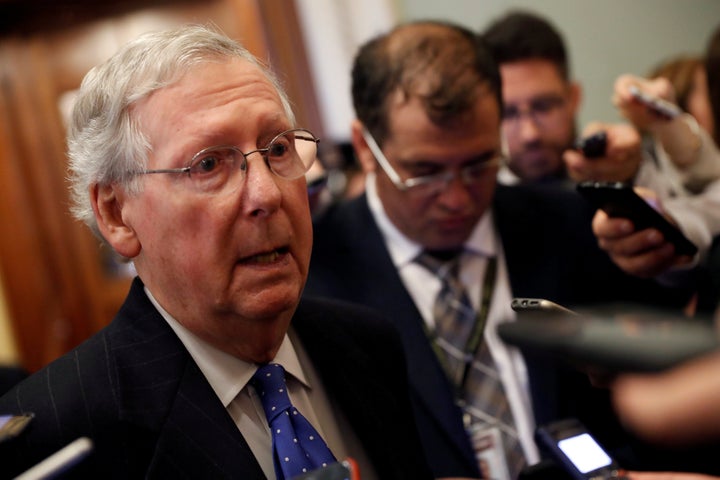
Steve Bannon, the avenging angel of establishment Republicans, recently told the New York Times, “I have an objective that Mitch McConnell will not be [Senate] majority leader, and I believe will be done before this time next year.” Bannon could well get his wish, though not quite in the way he intends.
Suddenly, a Democratic takeover of the Senate in the 2018 elections is not such a long shot. McConnell could well hand the gavel over ― not to some Tea Party Republican backed by Bannon, but to Democratic leader Chuck Schumer.
Thanks to Bannon, Republicans are now saddled with a nominee in the December 12 Alabama special senate election, ousted Judge Roy Moore, who was already at risk as too crackpot even for Alabama — and that was before several women came forth and credibly accused Moore of molesting them as teenagers. Polls now show the Democrat, Doug Jones, tied or even slightly ahead.
Meanwhile, in neighboring Tennessee, Bannon and Trump hounded incumbent senator Bob Corker, a standard-issue right-wing Republican and chair of the Foreign Relations Committee, to the point where Corker decided not to run for re-election. Bannon has been hoping for a Tea-Party replacement; Trump wants someone more loyal to himself (note that these are not the same things). But instead they may get Phil Bredesen, a popular Democratic governor between 2006 and 2011, who is seriously considering running for the seat.
The serial insults of Trump and Bannon also induced Arizona senator Jeff Flake to forego re-election (as a Republican anyway.) Unlike Tennessee and Alabama, Arizona is a genuine swing state. If a far-right candidate is chosen as nominee, score Arizona as a potential Democratic pickup.
Likewise in nearby Nevada, Trump and Bannon have been savaging the incumbent, Sen. Dean Heller, as insufficiently radical right, and disloyal to Trump. This infighting will leave Nevada Republicans either with a wounded incumbent or with an insurgent nominee well to Heller’s right and a divided party. Nevada, which Hillary carried and whose other senator ― Catherine Cortez Masto ― is a Democrat, is another likely Democratic pickup.
Winning all four seats would create a Democratic majority of 52-48.
Bannon talks a good game about the greater electability of “economic nationalist” conservatives. But people who fit Bannon’s criteria tend to be so far to the right on other issues that they risk throwing swing seats to Democrats.
In the past decade, Republicans lost winnable Senate elections to Democrats because their nominees were just too far outside the mainstream or turned out to have embarrassing personal histories. Remember such candidates as Todd (“Legitimate Rape”) Akin in Missouri, whose sheer extremism helped elect Claire McCaskill? This is the toxic pool in which Bannon is fishing. We can only wish him well.

Until last Tuesday’s elections, the prospect of Democrats picking up the Senate and the House seemed wishful. Trump’s popularity ratings were low, but his base still mostly loved him. Winning the 24 seats needed to control the House seemed possible, but something of a stretch. Hardly anyone thought the Senate was conceivable, because Democrats are defending five or six difficult seats, and among GOP incumbents only Nevada and Arizona seemed vulnerable.
But after last Tuesday, it’s looking increasing as if the 2018 mid-terms could be a wave election — a blue wave.
For one thing, statewide and local legislative elections showed that Trump is monumentally unpopular in politically moderate suburbs. Trump carried disgruntled rural and working class white voters, plus just enough suburban voters to get elected. But the suburbs have had enough — and off-year elections are turning out to be referenda on Trump.
That puts GOP candidates for Congress and state legislatures in a real bind: either identify with Trump and alienate a good chunk of the Republican electorate; or distance yourself from Trump and alienate a different chunk.
The failed Republican candidate for Virginia governor, lobbyist Ed Gillespie, attempted the impossible straddle of distancing himself from Trump personally while trying to use Trump’s own racist and anti-immigrant playbook. It didn’t work.
The other stunning thing that happened last Tuesday is that new people turned out to contest local races in droves, and energized the Democratic side up and down the ticket. The conventional wisdom in politics is that down-ticket races don’t make much difference on the top-of-the-ticket outcome. That was also proven wrong.
This was bottom-up democratic politics, at its best. It was the excitement that the novices brought to the campaign — nearly all of them progressives — that helped lackluster moderate Ralph Northam win the governorship of Virginia by an impressive nine points.
Normally, the two off-year gubernatorial elections, in Virginia and New Jersey a year after the presidential year, are ho-hum, low turnout, low energy affairs. Not this time. Past off-year governors’ elections have been good predictors of whether a wave is coming.
Last Tuesday was also very good news in another respect. In recent weeks, the news about Democrats has been mostly glum — mainly stories of infighting between Bernie and Hillary factions, and between some groups focused on identity and others focused on economics. But Tuesday’s sweep showed that Democratic candidates and energized voters could put aside differences on behalf of the larger cause.
During the past several months, thousands of young progressives have expressed a willingness to run for office. The Democratic Congressional Campaign Committee began the year thinking that there were a maximum of 50 House seats held by Republicans that were worth contesting. After a large number of impressive candidates came forward to challenge Republicans who’ve gotten free passes, the number was increased to 70, then to 80. According to one source at the DCCC, after last Tuesday’s wins, it has been increased again to 91.
The phrase, “resistance candidates,” is now in common usage, and happily, it transcends factional divisions. But if Democratic schisms are healing, Republican ones are only widening.
Even without Steve Bannon pouring oil on the flames, the Republican Party would be seriously split between Trump-loyalist factions and ordinary conservatives who are quite sick of Trump. Now, to add to the mess, Trump is trying to unhorse right-wingers like McConnell and company, not over loyalty to Trump but because they do not subscribe to Bannon’s brand of white supremacist nationalism.
On Tuesdays and Thursdays, Bannon faults Trump. On Mondays and Wednesdays, he professes support for him. So, what was a deep two-way split is now a deeper three-way split.
Brother Steve, Bring it on.
Robert Kuttner is co-editor of The American Prospect and professor at Brandeis University’s Heller School. His forthcoming book is “Can Democracy Survive Global Capitalism?” (Norton, 2018)
Like Robert Kuttner on Facebook: http://facebook.com/RobertKuttner
Follow Robert Kuttner on Twitter: www.twitter.com/rkuttner
